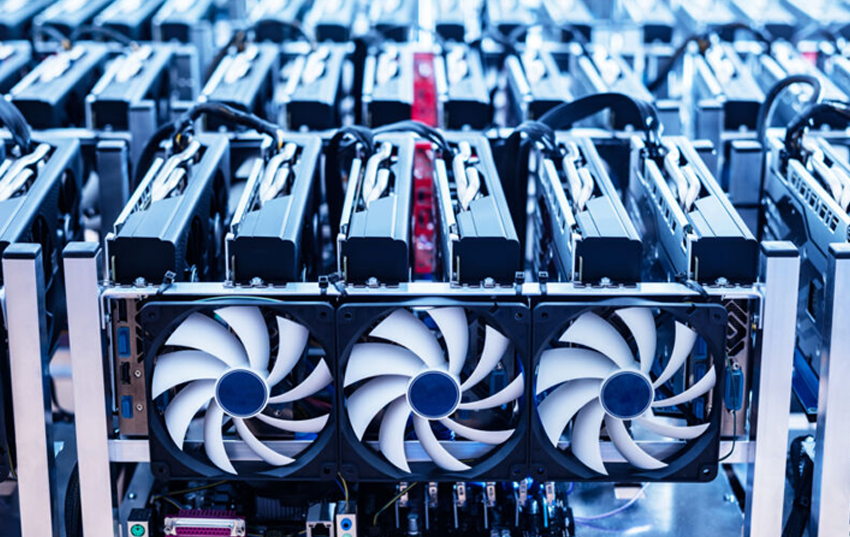
Source: iStock/NiseriN via Getty Images.
Attendees from across the world, including experts and enthusiasts in the field of bitcoin mining, convened at Mining Disrupt in Miami, a prominent conference and exhibition focused on the bitcoin mining industry. Taking place in late June, the event highlighted the latest advancements in products, solutions, and services. With the increasing prominence of AI, there is a growing emergence of facility designs that can cater to both bitcoin mining and AI data centers. This aligns with the initial trends observed, where certain mining farms are exploring opportunities to diversify their portfolios by incorporating high-density AI applications. By doing so, they aim to capitalize on the potential synergies between bitcoin mining and AI technologies.
Crypto landscape: growth & diversity
As of early 2024, the cryptocurrency market boasts more than 9,000 active digital currencies, representing a remarkable surge in the past decade. However, it is important to note that several cryptocurrencies have also become inactive or obsolete over time. When considering both active and inactive cryptocurrencies, the total number is estimated to be around 20,000. The cryptocurrency market is constantly evolving, with the emergence of various categories such as DeFi, meme coins, GameFi, stablecoins, privacy coins, and central bank digital currencies. These diverse categories contribute to the continuous growth and expansion of the cryptocurrency ecosystem.
Bitcoin mining’s shift towards centralization
Bitcoin mining plays a crucial role in securing the network, validating transactions, and introducing new bitcoins into circulation. It involves solving complex mathematical problems using specialized hardware, such as Bitcoin Miners. These devices, equipped with application-specific integrated circuits (ASICs), are optimized for the specific computations required in mining.
To increase their chances of success, individual miners often join mining pools, which combine their computational resources. The rewards are then distributed among pool members based on their contributed computing power.
However, the high costs of hardware and electricity have led to the centralization of mining power in regions with cheaper energy sources and among large mining pools. This centralization has given rise to bitcoin mining factories, also known as mining farms. These facilities are dedicated to large-scale mining and house numerous high-powered mining rigs in warehouses or other large buildings.
Bitcoin mining factories and AI datacenters
Bitcoin mining factories are specialized facilities that maximize efficiency and profitability in bitcoin mining. They leverage economies of scale, optimized resource management, and advanced cooling systems. Despite facing challenges such as high initial investment, energy consumption, and regulatory risks, mining factories play a crucial role in securing the network and validating transactions. Bitcoin mining factories and AI datacenters share similarities in terms of computational power, energy intensity, and specialized hardware. However, they differ in purpose, function, economic models, hardware specifications, flexibility, environmental impact, and operational requirements.
Bitcoin Miners use application-specific integrated circuits (ASICs), which are purpose-built for mining, while AI datacenters utilize graphics processing units (GPUs) for various parallel processing tasks. Bitcoin Miners have tower chassis designs, while AI datacenters use blade chassis designs. Additionally, bitcoin mining facilities often rely on fossil fuels, while AI datacenters are adopting renewable energy sources.
The role of liquid cooling in bitcoin mining factories
Both ASICs and GPUs are known for their energy-intensive operations. As a result, both bitcoin mining and accelerated computing, including GPU-based AI processing, have faced challenges in thermal management. However, they have taken different development paths to address these challenges.
In the bitcoin mining industry, cost efficiency is a key consideration. Legacy tower design miners, equipped with large heat sinks and fans, have been widely adopted to dissipate heat effectively. Liquid cooling is also being explored as a potential solution for next-generation mining equipment.
In terms of cooling approaches, immersion cooling gained more acceptance in the early days of bitcoin mining. This was primarily due to the minimal custom engineering required for the miner, compared to the cold plate approach. Additionally, ASIC boards are more resilient to nonconductive oil compared to GPU boards. Furthermore, the absence of a historical preference for rack-based installations, as seen in data centers, contributed to the popularity of immersion cooling.
The Mining Disrupt conference showcased some noteworthy developments that could indicate future trends in the bitcoin mining industry. Companies have started demonstrating modular designs based on standard shipping containers, allowing for easy integration with different cooling technologies and flexible deployment. This brings bitcoin mining operations closer to well-designed data center facilities.
Early trends
While tower chassis miners are still prevalent, rack-based blade chassis designs with cold-plate liquid cooling have emerged. These racks resemble GPU server racks, with the main difference being the redundancy of power distribution and cold-plate systems. In a cold-plate liquid-cooled GPU server, only the heat-generating GPUs are attached to the cold plate, while other components still require air cooling. However, bitcoin miners do not have storage or hard drives, simplifying their cold-plate systems. This design can accommodate both bitcoin mining and AI GPU servers with minor modifications.
As AI gains popularity, some mining farms are exploring opportunities to diversify their portfolios by incorporating high-density AI applications. This aligns with the growing interest in AI and the potential for synergies between bitcoin mining and AI technologies.
On the other hand, the cold plate approach is dominant in AI data centers. This is because it aligns with the traditional rack installation form factor commonly used in data centers.
Want insights on datacenter trends delivered to your inbox? Join the 451 Alliance.
Want insights on consumer technology trends delivered to your inbox? Join the 451 Alliance.
This content may be AI-assisted and is composed, reviewed, edited and approved by S&P Global in accordance with our Terms of Service.
